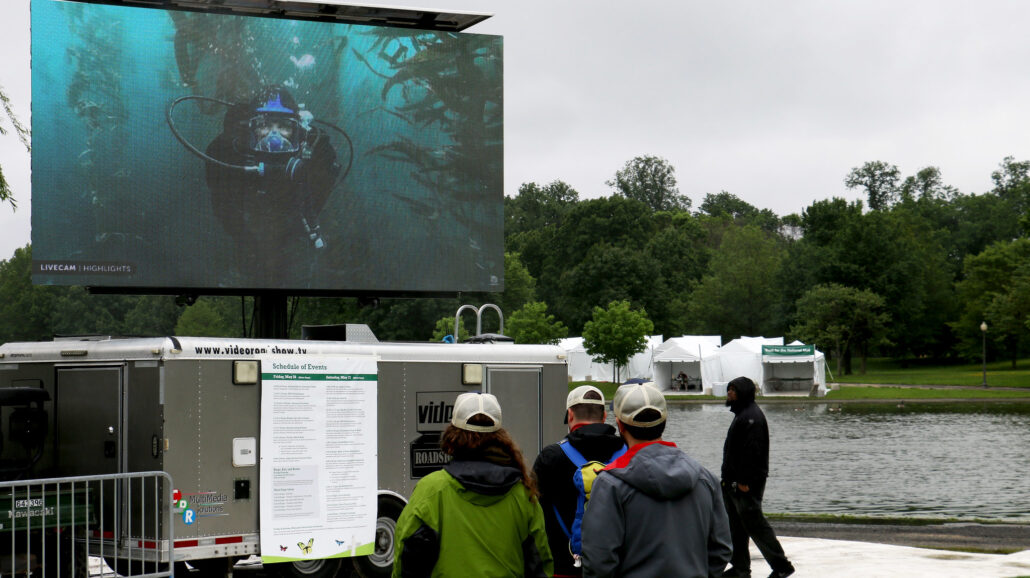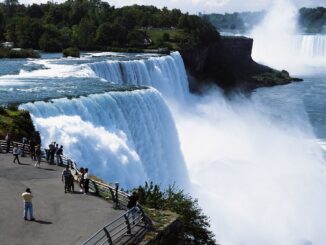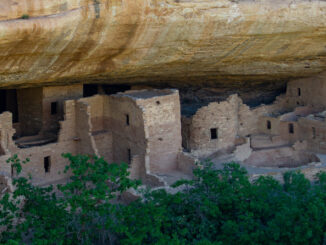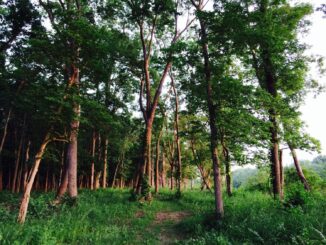
A popular National Park Service educational program that was shut down during the pandemic will be revived, an NPS official recently confirmed during a public lecture.
The program, Channel Islands Live, has been off-the-air for 4 years.
Channel Islands National Park managers hosted Channel Islands Live regularly before broadcasts were put on hold. The online broadcast segment featured park staff in scuba gear leading schoolrooms across the nation in underwater lessons on the park’s aquatic habitats and biology.
The presenters were equipped with full-face diving masks and microphones allowing them to interact live with students.
Channel Islands Live has been on hiatus since 2020. But in a recent public presentation Jasmine Reinhardt, Interpretation and Education Programs Manager at Channel Islands National Park, said NPS is working to revive the program.
“We’re really excited to say that we will be relaunching it soon,” Reinhardt said. “We are getting so close.”
Schools across the United States were closed during the COVID-19 pandemic as instruction was moved online. Without in-person classes and with the confusion that the pandemic delivered, NPS felt it made little sense to try to forge ahead with Channel Islands Live during the emergency.
With the pandemic over, NPS feels the timing is right to revive the educational program. Broadcasts are likely to resume this year.
Equipment overhaul
During the broadcast hiatus, much of the underwater equipment used to make Channel Islands Live show possible fell into disarray.
The need to fix, upgrade, or otherwise replace equipment has contributed to further delays in reviving the broadcasts. But Channel Islands National Park is close to overcoming those hurdles, Reinhardt said.
Comprising a chain of small islands off the California coast, much of Channel Islands National Park is underwater. The seas surrounding the islands are among the most biodiverse places in the United States. They’re home to lush underwater kelp forests popular with divers and underwater photographers.
Reinhard said the managers at Channel Islands National Park try to emphasize the underwater splendor of the park just as much as they promote the islands above-water terrain.
Thus, the popular underwater kids’ program is making a comeback, she said.
“It’s just here at the horizon that we’re hoping to officially restart Channel Islands Live this coming academic school year,” she said, “something that the park has worked really hard on.”
A remarkable recovery story
Beyond its underwater wonders, Channel Island National Park has an important story to tell about evolution and conservation.
Comprised of five islands, the park is home to the island fox, a unique subspecies endemic to the Channel Islands. The species is also an example of island dwarfism, the tendency for some species to evolve to be smaller in size on some island ecosystems.
The island fox is the smallest canid species in North America, roughly a third of the size of the grey fox, it’s closest mainland cousin. The species is found only on the Channel Islands in California.
“Each island population is its own unique endemic species,” Reinhardt said.
The island fox also nearly became extinct.
Wildlife managers noticed a dramatic fall in populations of island foxes beginning in the 1990s. At the height of the crisis, San Miguel Island’s population fell to only 15 individual island foxes. Santa Rosa Island was found to be home to about the same number.
Less than 80 island foxes lived on Santa Cruz Island at the height of the population collapse.
During her presentation, hosted by California State Library and later rebroadcast on YouTube, Reinhardt said that conservation authorities eventually found the cause of the island fox’s population crash: a golden eagle invasion.
For the longest time, bald eagles were the main bird of prey found at Channel Islands National Park, and they generally left the foxes alone, preferring to catch fish. For some reason, bald eagles were pushed out by golden eagles that preyed on the foxes.
NPS officials solved the crisis but physically removing golden eagles from the islands and returning the nests to bald eagles. In response, the island fox population has exploded, representing a remarkably fast rebound for an endangered species that was once on the brink, Reinhard said.
“Demographic modeling incorporating the population survival estimates now predicts a very low risk of extinction for that recovery,” she said. Reinhardt called the island fox population rebound “the fastest successful recovery for any endangered species listed mammal in the United States, which is pretty extraordinary.”
Telling the human story
Channel Islands National Park hopes visitors will come away with an appreciation of the islands’ human story just as much as they will hopefully come to appreciate the marine and terrestrial wildlife and ecosystems.
Humans have been living on the Channel Islands for at least 13,000 years. The Chumash people called the islands home for centuries.
Last month, US National Park Service Director Chuck Sams visited the Channel Islands to take part in a Chumash tradition, a ceremonial crossing of Santa Barbara Channel in a traditional Chumash boat.
NPS said the journey took about eight hours. Geologists agree that the Channel Islands have never been attached to the North American mainland, but they were much closer to the mainland coast during the last ice age.
Sams said his participation was a way to signal NPS’s intention to work more closely with Native American communities.
“Much progress has been made in the last few decades, and there are many opportunities ahead for further collaboration on stewarding these sacred lands and waters,” Sams said.
The Chumash were forcibly removed from the Channel Islands in the 1800s. Still, they maintained their connections to the islands. NPS says it’s determined to make sure that those bonds are strengthened and never harmed again.
“Chumash life has never been separated from the Channel Islands,” NPS said in a release. “This crossing and arrival represent a sacred pilgrimage for this group, and an opportunity to spend time together on Santa Cruz Island celebrating indigenous culture and their deep spiritual connection to this island.”
©2025 Public Parks
Park Info
Park:
Channel Islands National Park
Location:
California, USA
More information:



